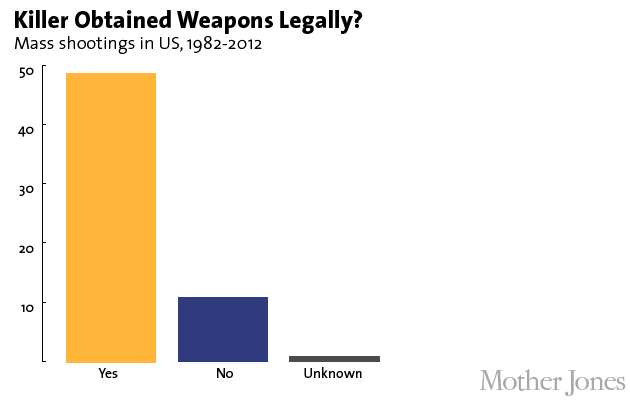Update, December 14: On Friday morning, 27 people were killed in a shooting at an elementary school in Newtown, Connecticut. Among the fatalities are 20 children, six adults, and the shooter. We're following this story closely with regular updates here. This guide and map have been updated with data from the Newtown massacre.
It's perhaps too easy to forget how many times this has happened. The horrific mass murder at a movie theater in Colorado on July 20, another at a Sikh temple in Wisconsin on August 5, another at a manufacturer in Minneapolis on September 27—and now the unthinkable nightmare at a Connecticut elementary school on December 14—are the latest in an epidemic of such gun violence over the last three decades. Since 1982, there have been at least 62 mass murders* carried out with firearms across the country, with the killings unfolding in 30 states from Massachusetts to Hawaii. We've mapped them below, including details on the shooters' identities, the types of weapons they used, and the number of victims they injured and killed.

Tragedy in Newtown
Weapons: Of the 142 guns possessed by the killers, more than three quarters were obtained legally. The arsenal included dozens of assault weapons and semiautomatic handguns. (See charts below.) Just as Jeffrey Weise used a .40-caliber Glock to slaughter students in Red Lake, Minnesota, in 2005, so too did James Holmes, along with an AR-15 assault rifle, when blasting away at his victims in a darkened movie theater. In Newtown, Connecticut, Adam Lanza wielded two handguns and a .223 Bushmaster semiautomatic assault rifle as he massacred 20 school children and six adults.
The killers: Half of the cases involved school or workplace shootings (12 and 19, respectively); the other 31 cases took place in locations including shopping malls, restaurants, government buildings, and military bases. Forty four of the killers were white males. Only one of them was a woman. (See Goleta, Calif., in 2006.) The average age of the killers was 35, though the youngest among them was a mere 11 years old. (See Jonesboro, Ark., in 1998.) Explore the map for further details—we do not consider it to be all-inclusive, but based on the criteria we used to identify mass murders, we believe that we've produced the most comprehensive rundown available on this particular type of traumatic violence. (Mass murders represent only a sliver of America's overall gun violence.) For a timeline listing all the cases on the map, including photos of the killers, jump to page 2.)
Hover over the dots or use the search box in the top-left corner of map to go to a specific location. (You'll need to zoom in to see the Fort Hood shooting, located close to another Texas massacre in 1991, and to see other proximate incidents in Denver, Seattle, and elsewhere.)
Sources: Research by Mother Jones. (With thanks to the Associated Press, Canada.com, and Citizens Crime Commission of NYC.)
We used the following criteria to identify cases of mass murder:
- The killings were carried out by a lone shooter. (Except in the case of the Columbine massacre and the Westside Middle School killings, both of which involved two shooters.)
- The shootings happened during a single incident and in a public place. (Public, except in the case of a party in Crandon, Wisconsin, and another in Seattle.) Crimes primarily related to armed robbery or gang activity are not included.
- The shooter took the lives of at least four people. An FBI crime classification report identifies an individual as a mass murderer—as opposed to a spree killer or a serial killer—if he kills four or more people in a single incident (not including himself), and typically in a single location.
- If the shooter died or was hurt from injuries sustained during the incident, he is included in the total victim count. (But we have excluded cases in which there were three fatalities and the shooter also died, per the previous criterion.)
- We included six so-called "spree killings"—prominent cases that fit closely with our above criteria for mass murder, but in which the killings occurred in multiple locations over a short period of time.
For more on how we determined the criteria, see our mass shootings explainer. Also: more on the crucial mental illness factor, and on the recent barrage of state laws rolling back gun restrictions across the US.
Here are two charts detailing the killers' weapons:
DANCING NEBULA

When the gods dance...
Sunday, December 16, 2012
A Guide to Mass Shootings in America | Mother Jones
via motherjones.com
Subscribe to:
Post Comments (Atom)


No comments:
Post a Comment